Many thanks to SWLing Post contributor, Richard Langley, who notes that HFCC A17 schedules for all stations are now available at http://www.hfcc.org/data/a17/index.phtml.
Thanks again, Richard!

Many thanks to SWLing Post contributor, Richard Langley, who notes that HFCC A17 schedules for all stations are now available at http://www.hfcc.org/data/a17/index.phtml.
Thanks again, Richard!
(Source: Finnish DX Association)
The Finnish DX Association wishes you all good DX for 2017.
We also have the pleasure of inviting all DXers and shortwave listeners to join the jubileum European DX Conference to be held in Tampere, Finland on 18-20 August 2017. It is time to celebrate, as this year is Finland?s centennial and The European DX Council will have its 50th anniversary. The meeting will be organized by The Finnish DX Association (soon to be 60 years) and Tampereen DX-Kuuntelijat (local DX club celebrating its 50th anniversary).
We will follow our tradition of successful EDXC conferences held in Finland in 1971, 1987, 1992, 2002 and 2008. So it will be three days of lots of program, lots of events and lots of fun.
We plan to open the website of this conference during January. The website will be set to be a part of the FDXA website www.sdxl.fi and when the conference site is open, a link ?EDXC Conference 2017? will be found on the main page.
The conference will start on Friday afternoon 18th of August and end on Sunday afternoon 20th of August. This time of summer is not anymore high-season in Finland, so if you like, you should be able to book extra nights pretty easily and with reasonable prices.
Also a post-conference tour is planned. This would last a few days and the target would be Finnish Lapland including visits to the well-known LEM and AIH DX sites and also possibly including a visit to Nordkapp (the northernmost point of the European continent). If you are interested in joining this tour, please don?t make any flight bookings yet.
The conference organizing committee has been set. The committee chairman is Risto Vähäkainu. You are welcome to address your special questions to rv at sdxl dot org.
Hoping to see many many of you in Tampere next summer!
Risto Vähäkainu
FDXALinks
- SDXL/FDXA, Suomen DX-liitto – The Finnish DX Association
- City of Tampere, read more in English, German, Russian and Finnish
- Conference hotel: Varala Sports Institute / Varalan Urheiluopisto (address: Varalankatu 36, Tampere) Google Maps, read more in Finnish.
Click here to read this post on the Finish DX Association website.
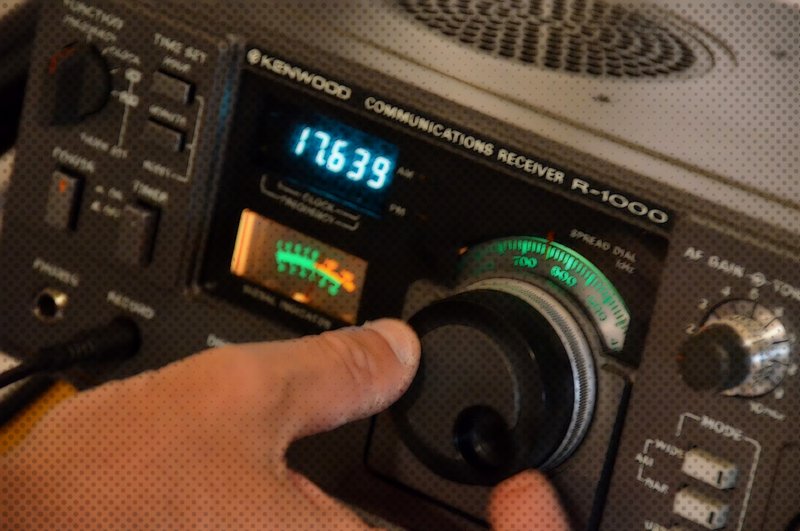 Many thanks to a number of SWLing Post readers who shared a link to this article via Radio Slovakia International:
Many thanks to a number of SWLing Post readers who shared a link to this article via Radio Slovakia International:
Why is shortwave radio still alive?
If you use the internet to listen to streaming audio and podcasts, you could be forgiven for assuming there’s no need for shortwave radio any more. It seems many broadcasters appear to agree, with stations dropping their shortwave services year after year.
But not so fast. Shortwave’s not dead, say its proponents. Rather, it’s in a state of transformation. Not only does it still provide a vital service for the many millions of individuals worldwide who don’t have access to the internet, but this medium also has a certain ‘magic’ which, we discovered, is very hard for its fans to explain.
In this entertaining, full-length feature, Gavin Shoebridge asked shortwave listeners from across the globe to explain why they still use the service, why they don’t ‘go digital’, and where they think shortwave will be in the coming years.
Click here to download the MP3 audio.
Click here to read and listen via Radio Slovakia International.
(Source: Malay Mail Online via R. Lewis )
BANGKOK, March 8 — The BBC World Service has stopped broadcasting from one of its major global transmission stations situated in Thailand, AFP has learned, after talks broke down with a junta riled by its uncensored coverage.
Sources with knowledge of the negotiations said the BBC’s Thai-language output impeded discussions about renewing the 20-year lease on the complex, the network’s main shortwave broadcast station for Asia.
The centre’s large red and white transmission towers in Nakhon Sawan 240km north of Bangkok beamed local language news into tightly-controlled countries such as China and North Korea, and into places where many still rely on radio like Pakistan and Afghanistan.
– See more at: http://www.themalaymailonline.com/world/article/bbcs-thai-transmission-towers-fall-silent-as-junta-talks-falter#sthash.NsUkQnEQ.dpuf
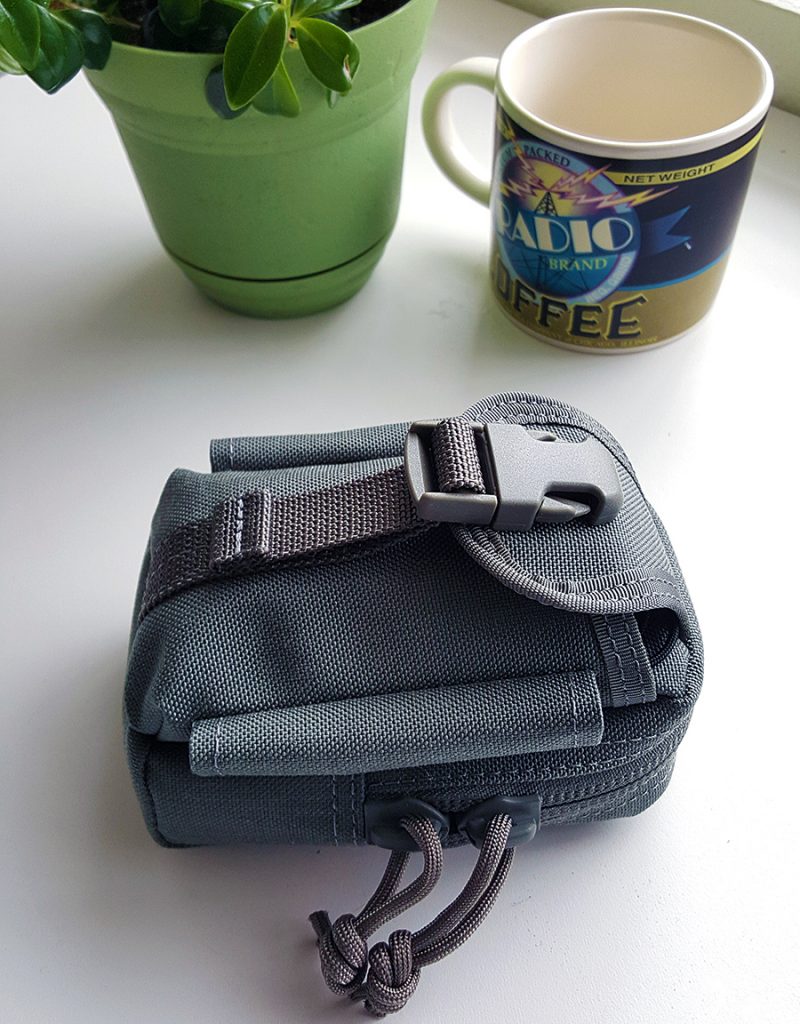 In a 2014 article, this site’s administrator Thomas Witherspoon introduced readers to the CIA’s Survival Kit which is housed in a superbly sturdy waistpack, the Maxpedition M-2. Thomas observed that the M-2 pouch is perfectly suited to holding the diminutive Sony ICF-SW100 receiver.
In a 2014 article, this site’s administrator Thomas Witherspoon introduced readers to the CIA’s Survival Kit which is housed in a superbly sturdy waistpack, the Maxpedition M-2. Thomas observed that the M-2 pouch is perfectly suited to holding the diminutive Sony ICF-SW100 receiver.
I was intrigued by that possibility, but only recently tried to combine the two after I resurrected another ICF-SW100 that fell silent to the chronic broken ribbon cable problem. Indeed, the radio is a perfect fit and the M-2 is impressively solid and well designed. I was not aware of the Maxpedition firm prior to learning of the M-2 bag, but I see in various forums they are a major player in well-made gear for the survivalist and outdoor enthusiast crowds. The M-2 is a very popular item, and one or more of the four available colors are sometimes out of stock at the manufacturer. Fortunately there are many sellers on Amazon and Ebay who have these waistpacks available.
What is EDC you may ask? It refers to “Every Day Carry”, the essentials that an individual deems necessary for their lifestyle or a particular activity. For me, an EDC bag is taken along on hikes or other outings to the countryside and typically contains a compact shortwave radio and related accessories. It’s always fun to stop for lunch or a break in a remote location and be able to search for interesting stations whenever the mood strikes.
This photo shows what I’m able to carry in the Maxpedition M-2 bag; a coffee mug is shown for size comparison. Contents of the “kit” include: 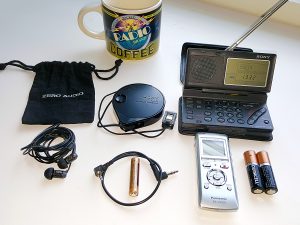
A few comments on the contents. The Zero Audio Carbo Tenore In-Ear Monitors (IEMs) provide excellent audio quality for their price. They are among a handful of IEMs regularly recommended by budget-minded audiophiles on the popular Head-fi.org site. I like these IEMs not only for the audio quality, but also their small size (in the cloth bag) which barely fits into the M-2’s main compartment along with the ICF-SW100. Larger earbuds or IEMs might not fit the M-2 without being mangled by the hefty YKK zippers. One caution: the similar Carbo Basso model by Zero Audio is deemed by many to be overly heavy on the bass frequencies. I find the Carbo Tenore to be more than sufficient for bass heavy genres like Electronica.
The Panasonic RR-XS400 digital voice recorder has been out of production a few years, but is 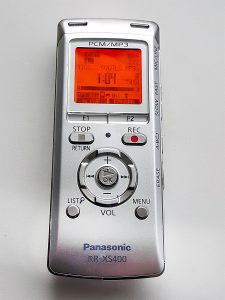 a highly capable and compact recorder. It contains a hidden USB plug for charging and data transfer, has a fully featured and backlit LCD display, built-in stereo microphones, switchable LINE/MIC inputs, and other useful features. In excellent used condition the RR-XS400 is worth about $50 USD in 2017, despite some Amazon sellers trying to move them at the original $280 price.
a highly capable and compact recorder. It contains a hidden USB plug for charging and data transfer, has a fully featured and backlit LCD display, built-in stereo microphones, switchable LINE/MIC inputs, and other useful features. In excellent used condition the RR-XS400 is worth about $50 USD in 2017, despite some Amazon sellers trying to move them at the original $280 price.
The extra AAA battery for the recorder slips into the front pouch of the M-2 bag along with the Sony AN-71 antenna. The additional AA batteries for the radio, however, are held in the two “pen loops” on the left and right of the M-2. Despite these loops being open-bottomed tubes, the fit is tight enough to hold the batteries securely.
Like every portion of the Maxpedition M-2 bag, the belt loop is proportioned perfectly and sewn with precision. With the Sony ICF-SW100 EDC “kit” secured to my belt on a hike, I’m assured of quick access to a DXing opportunity, such as when hiking the Naches Loop Trail near beautiful Mt. Rainier:
Guy Atkins is a Sr. Graphic Designer for T-Mobile and lives near Seattle, Washington. He’s a regular contributor to the SWLing Post.
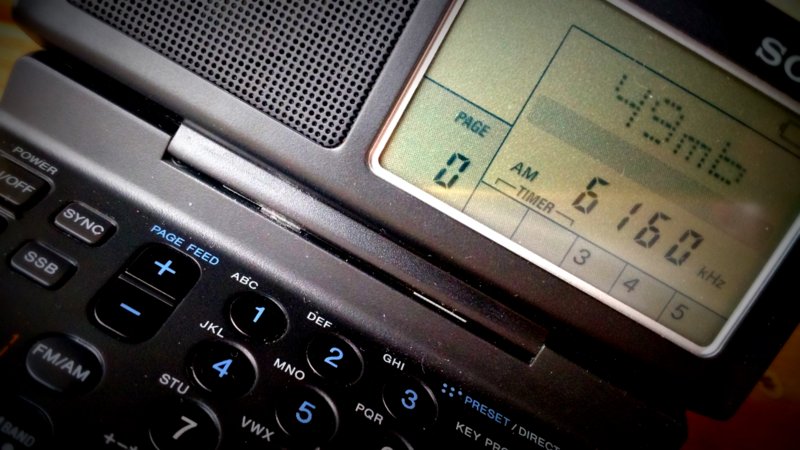 Many thanks to SWLing Post contributor, Dave Zantow, who writes:
Many thanks to SWLing Post contributor, Dave Zantow, who writes:
From DXLD today in case you missed it . Well at least CKZN St. Johns [also on 6160 @ 1kw] is still on (last I checked) , the one I can hear at my QTH.
***************************************************
Bad news re: CKZU 6160 KhzVolodya S
Fellas, from an insider at the CBC. Unfortunately, it doesn’t look good for CKZU ever returning to the air. 🙁 Thanks to Colin Newell for digging into this further.
Walt Salmaniw, Victoiria, BC
Got the answer.. not gonna like it.
Basically, it broke and they don’t have parts to fix it because it’s too old and no parts available. The money required to purchase a new transmitter doesn’t make sense because of the low numbers of people who use it (changing world, everything’s online, blah blah). Before you say it, yes I know, I know.Anyway, there is no other way to voice your displeasure than the 1-866-306-4636 audience relations number. If enough people call, they might notice, but I doubt it.
Sorry to be the bad news messenger. I kinda figured that was the deal of why it was off the air.
This is sad news indeed for those who enjoyed CKZU. What amazes me, is how a 500 watt shortwave relay covered such a large broadcast footprint in British Columbia and western North America.
On that note, I just discovered this post by Colin Newell (referenced above) on his blog, the Coffee Crew Blog. Colin mentions when he started listening to CKZU and what it meant to him. Check out his post.
CKZU was a reasonably tough catch here on the east coast of the US–especially due to CKZN who shared the frequency–though I’ve heard them numerous times. Indeed, this will prompt me to go back a few years in my SDR spectrum archive recordings and tune them in once again–sort of a postmortem DX–? I’m sure I’ve captured them.
As Dave mentions above, CKZN St. Johns is still on the air and, perhaps, listeners on the west coast will have a better chance snagging their 1 kW signal now. According to an article about CKZN in the latest WRTH, the station should be around for many years to come.
Thanks again, Dave, for the tip and many thanks to Colin for the research.
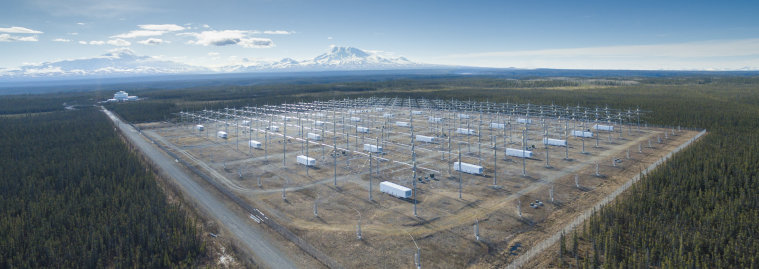 Many thanks to Chris Fallen (KL3WX), Assistant research professor in the University of Alaska Fairbanks Geophysical – Space Physics group , who shares the following update from the High Frequency Active Auroral Research Program (HAARP):
Many thanks to Chris Fallen (KL3WX), Assistant research professor in the University of Alaska Fairbanks Geophysical – Space Physics group , who shares the following update from the High Frequency Active Auroral Research Program (HAARP):
Campaign time!
Experiments begin in the mid morning 19 February Alaska Standard Time (AKST) and continue intermittently through the evening each day through 22 February.
Luxembourg Broadcast
The first radio modification of the ionosphere occurred in the early 1930s and was an accidental consequence of the new and powerful Radio Luxembourg transmitter. In certain situations, listeners of other weaker broadcast radio stations found that they sometimes heard Radio Luxembourg programming even though it was transmitted on a completely different frequency. Scientists and engineers eventually concluded that signals from powerful Radio Luxembourg and less powerful stations were being mixed in space, that is, through ionosphere modification.
HAARP will transmit a sequence of tones and music using amplitude modulation (AM) on two different radio frequencies (2.7 MHz and 3.3 MHz) in a sort of reproduction of this so-called Luxembourg Effect. If conditions are sufficient and you tune-in to one frequency or the other, you will hear tones and music from both frequencies. The tones and music have been specifically composed to take advantage of the Luxembourg effect.
The Luxembourg broadcast will begin as early as 6 p.m. on 19 and 20 February Alaska Standard Time (AKST) and conclude by 6:40 p.m. In Coordinate Universal Time (UTC), the broadcasts will begin as early as 03:00 on 20 and 21 February and conclude by 03:40. Tune in to 2.7 MHz or 3.3 MHz (2700 KHz or 3300 KHz), or both! The program is approximately 10 minutes in duration and will repeat until 6:40 p.m. AKST or 03:40 UTC.
Artificial Aurora
Aurora photographers in Alaska, Yukon Territory, and northwest British Columbia have a chance to photograph artificial aurora created with HAARP, starting immediately after the Luxembourg Broadcast and continuing until the ionosphere critical frequency over Gakona drops below about 2.7 MHz.
Radio listeners can still tune-in to these operations, but the transmissions are slightly more complex in order to test a scientific hypothesis. Also, at least in these initial experiments, the broadcast will only sound like a silent carrier wave, as if a radio DJ fell asleep and neglected to change the record (or now, more likely, the digital file). The specific transmission sequence is as follows:
MAIN: Repeat the following 480 second sequence if foF2 > 2.80 MHz
90 seconds : 2.80 MHz
30 seconds : OFF
90 seconds : 2.80 MHz, O mode, CW modulation, MZ direction
30 seconds : OFF
90 seconds : 2.82 MHz, O mode, CW modulation, MZ direction
30 seconds : OFF
90 seconds : 2.84 MHz, O mode, CW modulation, MZ direction
30 seconds : OFFBACKUP: Repeat the following 240 second sequence if foF2 < 2.80 MHz
90 seconds : 2.75 MHz
30 seconds : OFF
90 seconds : 2.75 MHz
30 seconds : OFF
Thank you, Chris.
Chris tells me that his campaigns are “strenuous chair-and-keyboard marathons” where, at times, he drives a mile or so to adjust cameras and drives back to the operations center to make adjustments there–the process being repeated many times over. I can only imagine how challenging it must be working with a site so vast.
Note that we have given Chris Fallen an account on the SWLing Post so he can directly post details about HAARP campaigns and research prior to and after events, when his time allows.